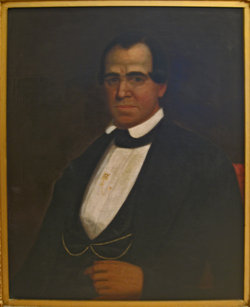I am choosing to study Rémy Mignot for my Charlestonian research project. I chose him because his epitaph is written in French, as opposed to English, which is interesting. He was born in France in on July 15, 1801 and died in Charleston on August 15, 1848. He is buried in Saint Mary of the Annunciation Cemetery.
 |
| Above is the grave of Rémy Mignot. |
Rémy Mignot was born in port city of Granville in lower Normandy, France. He arrived in Charleston in 1823 along with other French immigrants who were escaping the disturbances in Normandy following the fall of Napoleon.
He first got married to Elisabeth whom he had two children with. Following her death, he remarried to a woman named Théonie Marie Louise Alexandrine (de la) Rivière whom he had four more kids with. One of his children, Louis Rémy, would go on to become the most accomplished American landscape painter in the entirety of the nineteenth century
 |
| Above is a painting by Louis Rémy. |
Growing up, he was raised in a Catholic family, so when he came to Charleston he became part of the congregation of St. Mary of the Annunciation Catholic Church. He was so involved in the church that he became a sponsor for the baptisms of the French families.
 |
| Above is a portrait of Rémy Mignot. |
When he came to Charleston, he opened up a coffee shop and a confectionery on East Bay Street. After a little while, the shop moved from East Bay Street to King Street.
In 1848, Rémy Mignot passed away at the age of 47 from dropsy. Dropsy is “an old term for the swelling of soft tissues due to the accumulation of excess water” according to MedicineNet.
In the same year, there were 382 people in Charleston, South Carolina, who were diagnosed with and passed away from dropsy. At St. Mary of the Annunciation Catholic Church there are currently 12 people buried who passed away from the same deadly disease.































